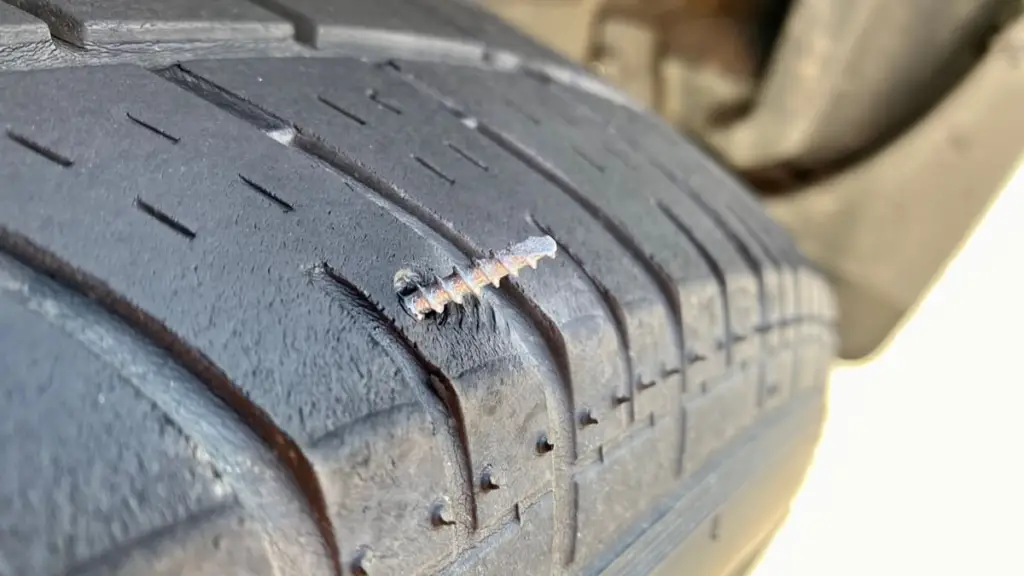Discovering a bolt in tire can be an unsettling experience. Whether you’ve encountered it while driving or noticed it during routine maintenance, a bolt can make driving risky.
Although you can drive with a bolt in your tire, it is not recommended. Because it is only safe to drive as long as the tire remains properly inflated. As soon as the air pressure gets reduced increasingly, you are at risk of a tire puncture. So, always get the tire fixed as soon as you can if you find a bolt in it.
Now, we have included a clearer idea of a bolt in a tire and the risk associated with it. So, if you want to know more about it, let’s get started.
Can You Drive with a Bolt in Tire?
Yes, you can drive with a bolt in the tire as long as the tire is holding air. But it is not safe to drive with a bolt in a tire. A bolt in the tire can cause problems even if it is not leaking air. Whether the tires are flat or deflated, a tire with low pressure is not safe for the road.

While driving, leaving the bolt in the tire can make the area unstable, potentially causing tread separation. Ideally, you should have the tire puncture repaired immediately. If it is fixable, opt for a repair. If the tire needs to be replaced, install a new one.
The cost of addressing the issue promptly is insignificant compared to the potential consequences of causing a major accident. Do not take any chances with your safety.
What Happens if I Don’t Remove the Bolt?
Driving with a screw in the tire can cause further damage, especially if the bolt is in the sidewall. This increases the likelihood of a blowout. You should place your spare tire on your spare if you see a screw in the sidewall.
The bolt may act as a temporary plug and maintain pressure for a certain distance. But you may start experiencing issues with the wheels. Thus, low tire pressure can cause rough driving or a feeling of imbalance in the car.
Some individuals choose to drive on the punctured tire, filling it with air as needed. This is because the tire will eventually need to be replaced, so they want to maximize its life.
However, this can pose a danger to yourself and others, particularly if the hole enlarges suddenly and causes a rapid loss of air. Using pliers, you can try removing the screw yourself if it is small and easily removable.
But, this approach is not without risk, as you cannot be certain of the screw’s length and potential damage. It is generally recommended to have a mechanic remove the screw and patch up the hole.
What To Do if the Bolt is in the Tire but Air is not Leaking?
You should take your car to a tire shop to have the lodged bolt removed to ensure safety. Just like the wire sticking out, you need to fix this as soon as possible.
The bolt in the tire may not have caused an immediate leak as it did not penetrate the tire. Over time, the bolt can leak as the tire tread wears and flexes, pushing it deeper into the tire.
How to Fix a Tire with Bolt?
Whenever you find a bolt in the tire, remove it as soon as possible. Here are the steps to follow for replacing a damaged bolt in your tire:
Step 1: Locate the Bolt by Inspecting the Tire – In most cases, the tire-mounted bolt will be visible. If not, you can spray the tire with a bubbling solution. Then reinflate it to check for air bubbles that indicate the leak and help pinpoint the hole more precisely.
Step 2: Physically Remove the Bolt – Use the appropriate tools to remove the bolt from the tire. Don’t worry if you hear a hissing sound or the air escaping; it’s normal.
Step 3: Ream the Hole – After removing the bolt, it’s time to ream the hole. Tire plug kits often include a tool with a file at the end. Use this tool to roughen the inside of the hole by pushing it in and out a few times.

Step 4: Insert the Tire Plug – Next, you’ll see a tool that looks like a needle. Take a plug and crimp its ends together. Insert the needle with the plug-threaded tip into the hole. Make sure to apply enough pressure so that only a small part of the plug is visible.
Remove the plug tool from the tire while leaving the plug in the hole. Trim the protruding end of the plug as close to the tire as possible.
But if you are not comfortable working with tools then seek professional help. It’s essential to have a trained technician handle the repair. Refer to your tire plug kit’s instructions to determine how far you can drive with a plugged tire.
To prevent further damage, remove any bolt or sharp object lodged in your tire promptly.
Can You Patch a Tire with Bolt?
Yes, you can patch a tire with a bolt unless it is in the sidewall of the tire. Because if the bolt is in the sidewall of the tire, the tire is damaged. Then you need to buy a new one.
However, the patch will not permanently secure the inner liner and there is also the risk of losing air. Besides, the gap left by the sharp object will not be properly filled. So, overall patching the tire is just a quick temporary solution.
Frequently Asked Questions (FAQs):
What’s The Difference Between Plugging And Patching Tire Bolts?
Tire Plugging means a small piece of rubber is incorporated into the puncture. This is to seal the hole and allow the tire to keep re-inflated. Tire patching means applying a patch to the inside of the tire to seal the hole. The process is slightly more complex and involves using tire cement and buffing tools.
Are There Specific Types of Tires More Prone to Bolts?
No, there is no specific type of tire that is more prone to bolt. Tires are normally made with rubber-based compounds. This makes them susceptible to being punctured by sharp objects.
Should I Check The Tire’s Steel Belts After Fixing A Bolt?
Yes, you should check the tire’s steel belts after fixing a bolt. But this is not a necessary step but rather a precaution. If the tire’s steel belts are damaged, wires will come out. This can lead to severe road hazards.
Conclusion
In conclusion, it is not safe to drive with a bolt in tire.
You are getting into serious risk by driving with a bolt in the tire. However, if you find yourself in such a situation then do not hesitate to remove it. It is easy to fix this problem. But if you are comfortable doing it yourself then always consult a professional for help.
